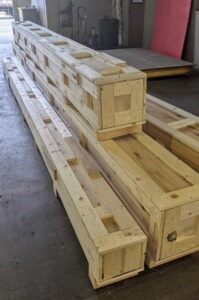Embarking on international shipping presents a myriad of challenges and considerations, with the foundational aspects of crate regulations serving as a compass through the complexities. In this comprehensive guide on international shipping crates , we dissect key elements, from understanding crate dimensions and materials to navigating customs with precision.
As we navigate the intricate landscape of international shipping, the spotlight is also on the imperative “Bug Stamp” and the proactive measures exemplified by companies like BlueRose Packaging in preparing for inspections. Let’s unlock the borders and delve into the intricacies of international shipping crates.
Understanding Crate Dimensions and Materials
While there are no strict and rigid rules regarding cargo height and weight limits, shipping companies often necessitate prior approval permits for the following scenarios:
- Cargo exceeding 70 inches in height
- Cargo surpassing 119 inches in length
- Cargo wider than 80 inches
- Cargo with a weight exceeding 2,200 pounds
To facilitate smooth shipping and handling, it is advisable for your cargo to be placed on a pallet or skid with a minimum clearance of 3.5 inches. This ensures that the cargo can be easily lifted using a forklift or pallet jack. Crates equipped with built-in pallets are particularly advantageous for this purpose, streamlining the shipping process and contributing to efficient handling.
Labeling and Documentation for International Shipping Crates
Proper labeling and documentation are your passports through customs. Create detailed shipping labels adhering to international guidelines. Documentation includes:
- Bill of Lading: Details transportation and route.
- Packing List: Covers cargo specifics like weight, volume, and value.
- Commercial Invoice: Proves sale details for customs.
- Certificate of Origin: Certifies the origin country.
- Letter of Credit: Bank-issued payment guarantee.

Always check specific country requirements and consult a customs broker for tailored advice. When partnering with BlueRose Packaging, rest assured that our team goes beyond mere guidance – we craft solutions that align with international regulations, providing you with the assurance of a seamless and compliant shipping experience.
Compliance with Destination Country Regulations
Understanding destination-specific shipping regulations is crucial, and one key aspect is the requirement for the ISPM 15 stamp, commonly referred to as the “Bug Stamp.” In most countries, wooden crates and packing materials must carry this stamp, serving as a certification that the wood used in their construction is free from insects, pests, and fungus.
Packaging materials encompass items like wooden drums, crates, pallets, cases, and dunnage employed for cargo cushioning.

The ISPM 15 stamp, crucial under the International Plant Protection Convention, mandates heat treatment or fumigation for wooden crates, eliminating insects and fungus. Post-treatment, wood receives the ISPM 15 stamp, company logo, and treatment date.
This international standard safeguards the integrity of shipments and contributes to a secure and pest-free global trade network. Be sure to adhere to these regulations to facilitate smooth customs clearance and maintain the quality of your cargo throughout its journey.
Crate Design and Construction: Maximizing Efficiency and Sustainability
Impact of Crate Design on Shipping Costs:
Delve into the realm of crate design with a focus on achieving a harmonious blend of cargo integrity and budget optimization. Explore innovative and cost-effective designs that not only safeguard the safety of your goods but also positively influence shipping costs.
By strategically planning crate dimensions and materials, companies can enhance efficiency in transport while keeping expenses in check. This balance ensures that your cargo arrives intact without unnecessarily burdening your budget.
Sustainable Crate Options for the Eco-Conscious Era:
In the context of today’s environmentally aware landscape, it’s crucial to consider sustainable crate options. Embrace materials and designs that not only meet shipping regulations but also align with broader environmental goals. Opting for eco-friendly crate solutions not only benefits the planet but also reflects positively on your business.
It’s a strategic and ethical choice, contributing to a greener supply chain and meeting the expectations of eco-conscious customers. By integrating sustainability into your crate choices, you create a win-win situation for both your business and the environment.

Navigating Customs: Tips for a Smooth Journey
Importance of Accurate Declarations
Accurate declarations are the linchpin for customs clearance. Furnish meticulous information to befriend customs processes, expediting clearance and mitigating unnecessary delays. Precision in your declarations is paramount; it establishes transparency, fostering a smoother journey through customs checkpoints. Ensure a swift customs process by giving thorough shipment details. Comply with regulations, earning trust for efficient clearance. This blog is crafted for BlueRose Packaging.

Preparing for Inspections
Anticipate potential inspections by customs authorities through proactive measures. To enhance the chances of a hassle-free inspection, consider the case of BlueRose Packaging. Implementing rigorous quality control and adherence to international standards, BlueRose Packaging takes a proactive stance to ensure their shipments pass inspections with ease. By consistently meeting or exceeding regulatory requirements, this company exemplifies the proactive steps businesses can take.
Incorporating these principles into your customs navigation strategy ensures a seamless journey, and emulating the diligence of companies like BlueRose Packaging can serve as a valuable guide in preparing for inspections.
Conclusion:
In conclusion, BlueRose Packaging shines as a model of excellence in international shipping crates. Through meticulous quality control and steadfast adherence to global standards, the company consistently surpasses regulatory requirements, ensuring their shipments navigate customs inspections seamlessly. BlueRose Packaging sets a commendable standard for businesses navigating the complexities of international logistics, showcasing the power of preparation and commitment to excellence.
Frequently Asked Questions (FAQ):
Q. What is the significance of accurate declarations in customs clearance?
A. Accurate declarations are crucial for customs clearance as they expedite the process and prevent unnecessary delays. Providing precise information establishes transparency, fostering a smoother journey through customs checkpoints.
Q. Why is the “Bug Stamp” (ISPM 15) important in international shipping?
A. The “Bug Stamp” or ISPM 15 is crucial as it certifies that wooden crates and packing materials are free from insects, pests, and fungus. This stamp, endorsed by over 180 countries, safeguards the integrity of shipments and contributes to a secure, pest-free global trade network.
Q. How can sustainable crate options benefit businesses in international shipping?
A. Sustainable crate options align with environmental goals and international shipping regulations. Choosing eco-friendly materials not only contributes to a greener supply chain but also reflects positively on businesses, meeting the expectations of eco-conscious customers.
Q. Why is efficient crate design important for balancing cargo integrity and budget optimization?
A. Efficient crate design ensures that cargo is both protected and shipped cost-effectively. Strategic planning of dimensions and materials enhances transport efficiency while keeping expenses in check, achieving a balance between cargo safety and budget considerations.

